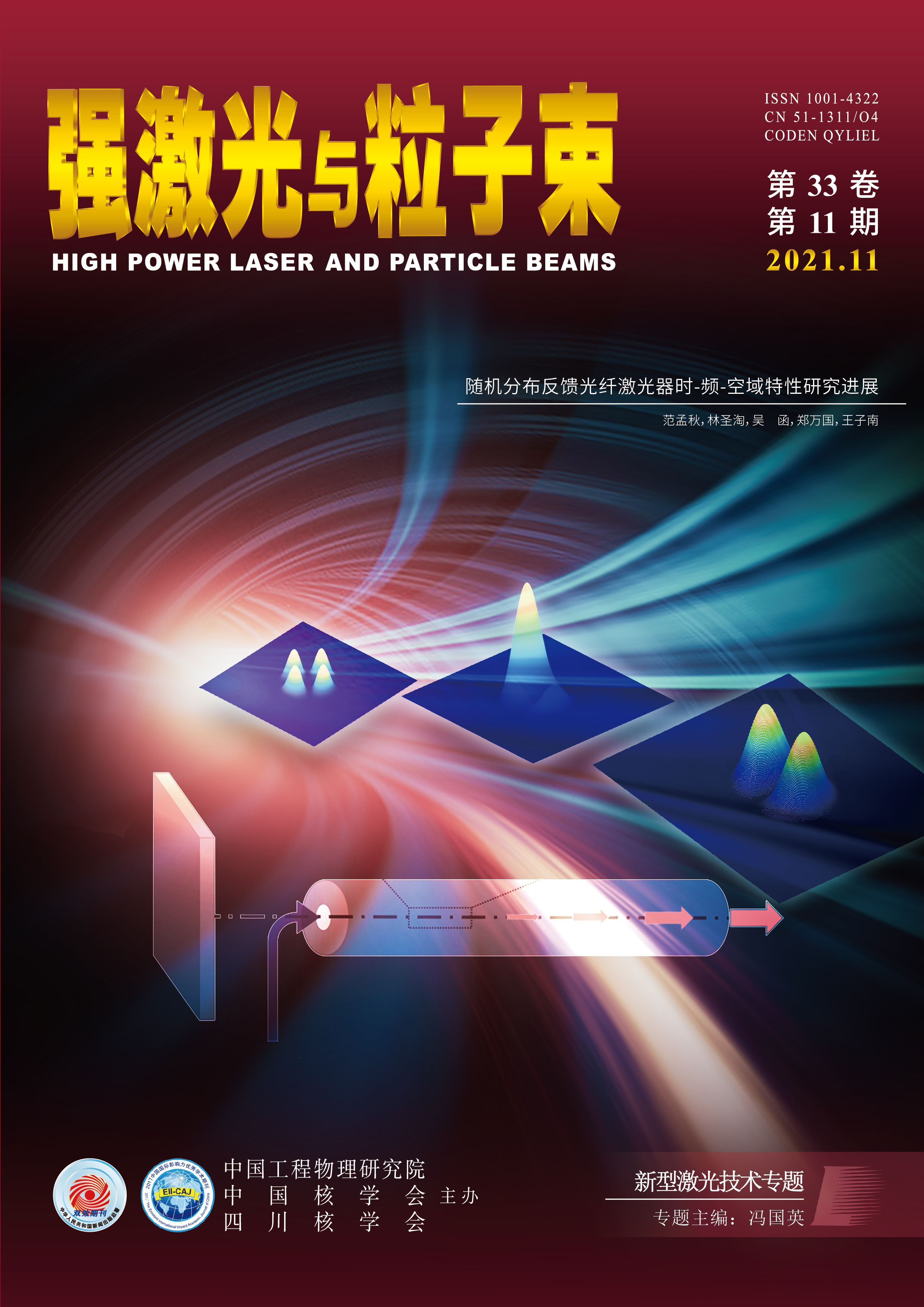2021 Vol. 33, No. 11
- Cover and Contents
- Feature Issue on Novel Laser Technology
- High Power Laser Physics and Technology
- Inertial Confinement Fusion Physics and Technology
- High Power Microwave Technology
- Particle Beams and Accelerator Technology
- Pulsed Power Technology
- Nuclear Science and Engineering
- Advanced Interdisciplinary Science
A mid-infrared fiber laser operating at λ≈3 μm is demonstrated using a Ho3+/Pr3+ co-doped AlF3-based glass fiber as a gain fiber. Under 1150 nm single-mode fiber laser pumping, the fixed-wavelength laser had maximum output power of 1.02 W, a slope ef...
Due to the great application potential in various fields such as spectral beam combination, photoacoustic spectroscopy and nonlinear frequency conversion, high-power spectrum-tunable fiber lasers have gained much attention in recent years. Based on a...
The recent research progress of random distributed feedback fiber lasers in the time-frequency-spatial domain is systemically reviewed in this paper. The factors influencing the time-frequency-spatial dynamic characteristics of random distributed fee...
Mid-infrared (MIR) lasers have various advantages and can be widely used in either fundamental research fields or practical applications such as strong-field physics, molecular sensing and minimally-invasive tissue ablation. Generally, there are two ...
Mid-infrared region ranging from 2.5 μm to 25 μm covers absorption lines of most molecules and multiple atmospheric windows. The ultrafast lasers operating in this waveband have vast applications in many fields. In recent years, significant progress ...
An alternative approach to realizing room temperature spintronic applications is introducing spin-polarized carriers in a semiconductor laser, which is beyond the usual magnetoresistive effects. Spin lasers have been widely applied in the fields of s...
Stimulated Brillouin scattering (SBS) is a third-order nonlinear process, which is phased conjugation reflected in the SBS phase conjugation mirror (SBS-PCM). Therefore, it is a very useful tool for the compensation of wavefront distortion induced by...
We demonstrated a self-starting mode-locked Ti:sapphire laser by using a synchronously pumping scheme with a frequency doubled femtosecond Yb fiber laser. By carefully adjusting the cavity length of the Ti:sapphire oscillator to match the fiber laser...
In this paper, the integrated mode measurement and control method based on fractional Fourier transform is proposed. The fractional Fourier transform optical system is used to modulate the spatial and phase distributions of the fiber mode coupling st...
This paper proposes an all-fiber Mach-Zehnder Interference (MZI) dual-parameter sensor based on S-shaped-dislocation structure. The sensor is prepared by using fusion splicer through simple discharge and fusion splicing steps, with pieces of single-m...
Tapered fiber has unique advantages in suppressing nonlinear effects because its core radius increases uniformly along the length of the fiber. In this paper, the output spectrum evolution and Raman performance of three different types of passive fib...
In view of the key bottleneck that Fe2+: ZnSe laser lacks effective high-power pumping source at present, the technical route of using a continuous wave HF chemical laser to pump Fe2+: ZnSe to achieve laser output in 4 μm band is proposed. The feasib...
To establish the effective evaluation about damage properties of large-aperture and high-energy optic components, we studied the statistics of the surface damage of the DKDP component. We analysed and summarized various kinds of damage distributing i...
Temperature has an important influence on the performance index and working life of distributed feedback (DFB) laser. Aiming at the laser application in a wide temperature range, the research status and trend of laser temperature control system are a...
The hot image effect of the high power laser system may cause the peak power of the beam to increase drastically, and the amplifying Keer medium will make this increase in light intensity more intense. When the input beam power is strong enough, the ...
This paper uses the two-dimensional particle-in-cell simulation program EPOCH to verify the feasibility of the relativistic electron beam probe in diagnosing the electrostatic wave generated by stimulated Raman scattering. The results show that the e...
The high-frequency slow-wave structure of 2−18 GHz ultra-wideband traveling-wave tube (TWT) is studied and analyzed to meet the requirements of modern information warfare for TWT. Based on the traditional wideband TWT, the positive dispersion charact...
To verify whether the parameters of the domestic proton injector meet the requirements, a beam diagnostic system was designed to measure the current, emittance, energy and energy spread of the domestic proton linear injector beam. This beam diagnosti...
A new kind of sensor Turbo-ICT has been applied to accurate bunch charge measurement in BEPCII transportation line. The system improves the resistance ability against external interference and has high signal-to-noise ratio. This paper introduces the...
As the key component of the electromagnetic pulse simulator for steepening pulse output, the peaking capacitor is prone to surface discharge and breakdown in practical engineering applications. The photoelectric detection system can effectively analy...
To meet the demand of irreversible electroporation for nanosecond pulse power supply, this paper proposes a sub-microsecond high voltage pulse power supply with high repetition frequency, which is based on positive Marx circuit and has ns rising time...
Applying series and parallel structure, a high current pulse generator was designed with thyristor. By analyzing the conducting current in circuit, the self triggering principle of the pulse generator is described. The variation of magnetic field in ...
To solve the problem of selecting shape and size of the pinhole in the full-field X-ray fluorescence (XRF) imaging, the Geant4 Monte Carlo simulation software was used to simulate pinholes of 6 different types and 4 different diameters. The effects o...
Surface-enhanced Raman spectroscopy (SERS) technology has been widely used in viral molecular detection due to its high sensitivity, simple operation and rapid detection. The research of virus detection by Raman technology at home and abroad mainly f...




 Email alert
Email alert RSS
RSS

